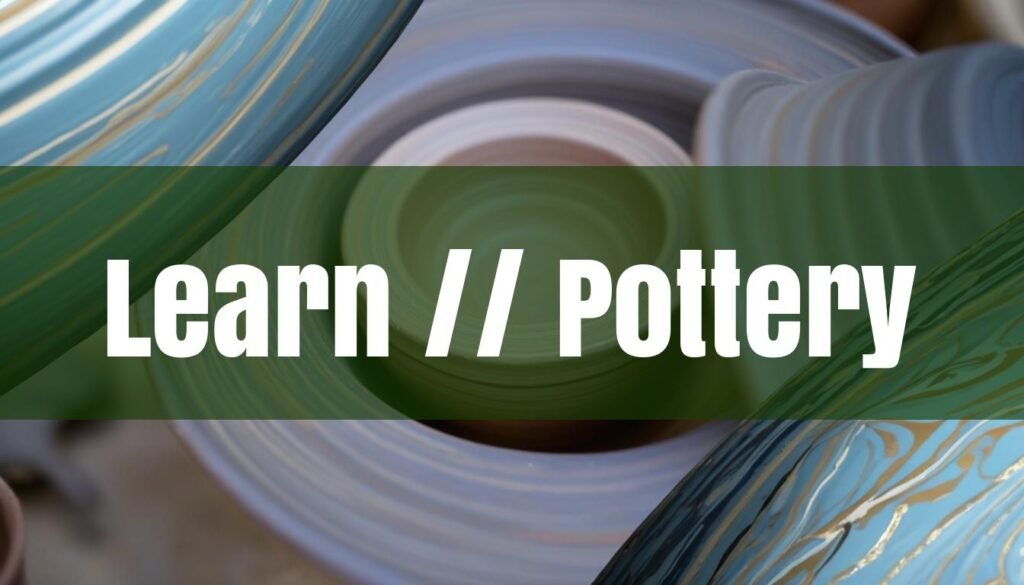For those captivated by the allure of shaping earth with their own hands, the journey into pottery offers a fulfilling blend of creativity and craftsmanship. If you’re wondering “where to learn pottery?”, the good news is that numerous avenues cater to various learning styles, budgets, and goals. From formal academic programs to cozy community workshops and the convenience of online tutorials, there’s a path for every aspiring potter. You may even be inspired by different Native American pottery traditions.
Formal Education: Universities and Community Colleges
For a comprehensive and structured learning experience, consider enrolling in pottery courses at universities or community colleges. University programs often delve into the theoretical aspects of ceramics, including art history, design principles, and advanced techniques. These programs usually culminate in a degree, providing a strong foundation for a career in the ceramic arts. However, the cost and time commitment can be significant, and the curriculum may not always align with purely recreational interests. Community colleges, on the other hand, offer more accessible and affordable options. Their courses typically focus on practical skills, covering fundamental techniques like wheel throwing and hand-building. The instructors are often experienced potters with a passion for teaching, and the learning environment is typically more relaxed and community-oriented. While community college courses may not provide the same depth of theoretical knowledge as university programs, they offer a solid starting point for beginners and a great way to develop practical skills. Both options provide access to well-equipped studios and kilns, essential for firing your creations, and the opportunity to learn alongside fellow enthusiasts, fostering a supportive and collaborative atmosphere.
Informal Learning: Community Centers, Private Studios, and Workshops
If formal education seems too daunting or time-consuming, explore the world of informal learning through community centers, private studios, and workshops. Community centers often offer pottery classes at affordable rates, making them an excellent option for budget-conscious learners. These classes typically cover basic techniques and cater to a wide range of skill levels. Private studios provide a more intimate and personalized learning experience. With smaller class sizes and individualized attention from the instructor, you can progress at your own pace and focus on specific areas of interest. Workshops, on the other hand, offer intensive learning experiences focused on specific techniques or themes. These can range from weekend workshops on glazing to week-long courses on alternative firing methods. The advantage of workshops is the opportunity to learn from experienced artists and immerse yourself in a particular aspect of pottery. When choosing a class or workshop, consider the instructor’s expertise, the learning environment, and the availability of equipment and materials. Don’t hesitate to ask questions about the curriculum, teaching methods, and studio policies to ensure it aligns with your goals and preferences.
Online Pottery Courses and Tutorials
In today’s digital age, online pottery courses and tutorials have emerged as a convenient and accessible way to learn the craft. Platforms like Skillshare, Udemy, and YouTube host a vast array of pottery tutorials, ranging from beginner-friendly introductions to advanced techniques. Online courses offer flexibility, allowing you to learn at your own pace and on your own schedule. They also tend to be more affordable than in-person classes. However, online learning has its limitations. It lacks the hands-on guidance and immediate feedback that you would receive in a physical classroom. It can also be challenging to troubleshoot problems or ask questions in real-time. Despite these limitations, online resources can be a valuable supplement to in-person learning or a good starting point for those who are unable to attend physical classes. When choosing online resources, look for reputable instructors with experience and positive reviews. Consider the course structure, content, and learning materials to ensure they align with your skill level and learning style. Remember that pottery is a tactile and experiential art form, so try to complement online learning with hands-on practice whenever possible.
Choosing the Right Learning Method
Ultimately, the best way to learn pottery depends on your individual goals, budget, and learning preferences. If you’re seeking a comprehensive education and career prospects in ceramics, a university program may be the best option. If you’re looking for an affordable and practical introduction to pottery, community college courses or community center classes could be a good fit. If you prefer personalized instruction and a more intimate learning environment, consider private studios or workshops. And if you value flexibility and convenience, online courses and tutorials can be a valuable resource. Before committing to a class or workshop, visit the studio, observe a class in progress, and talk to the instructor and students. Ask questions about the curriculum, teaching methods, studio policies, and equipment. Consider the learning environment and whether it feels comfortable and supportive. Starting pottery can be expensive, considering equipment such as a Kiln ($500 – $6500) and a pottery wheel ($200 – $2500) are required. Starting with beginner clay is important to become more proficient, with mid-range stoneware being very forgiving. Explore your local arts community and connect with other potters for advice and support. Many pottery studios offer open studio time, where you can practice your skills and work on your projects independently. Pottery is a journey of exploration and discovery, so embrace the process, be patient with yourself, and enjoy the creative possibilities that await you.
Essential Techniques and Tools
As you embark on your pottery journey, familiarizing yourself with basic techniques and essential tools is crucial. Handbuilding techniques like pinching, coiling, and slab construction are excellent starting points. Pinch pots, made by shaping a ball of clay with your fingers and thumb, are a simple yet satisfying way to create small vessels. Coiling involves rolling out long ropes of clay and joining them together to build larger forms. Slab construction uses flat sheets of clay to create geometric and structural pieces. These methods will help you understand the nature of clay and develop your hand skills. You can fix edges of slabs together using bevelling tools. When it comes to tools, a basic toolkit should include a sponge for smoothing and cleaning, a needle tool for scoring and piercing clay, a wire cutter for slicing clay, a wooden rib for shaping and smoothing on the wheel, and trimming tools for refining your forms. Other useful tools include brushes for applying slip and glaze, calipers for measuring dimensions, and an apron to protect your clothes. As you progress, you can expand your tool collection to include specialized items like loop tools, ribbon tools, and modeling tools. For example, to add creative textures, try using stamps.
Common Mistakes and How to Avoid Them
Like any craft, pottery involves a learning curve, and beginners are bound to make mistakes. One common mistake is improper wedging, which can leave air pockets in the clay and cause explosions in the kiln. To avoid this, wedge your clay thoroughly by cutting it into sections, slamming them together, and kneading it until smooth and consistent. Another common mistake is failing to center the clay properly on the wheel. This can lead to wobbly and uneven forms. Take the time to master the art of centering by applying even pressure to the clay and keeping your hands steady. Uneven walls are another frequent problem, which can result from inconsistent pressure or an off-center base. Pay close attention to the thickness of the walls as you shape your piece and use your hands and tools to maintain an even consistency. Rushing the drying process can also lead to cracking or warping. Allow your piece to dry gradually, covering it loosely with plastic to slow the drying rate. Remember, mistakes are an inevitable part of the pottery journey, so don’t get discouraged. Learn from your errors, seek guidance from experienced potters, and keep practicing to refine your skills.





